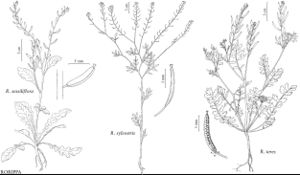Rorippa sylvestris
Enum. Pl., 27. 1821.
Perennials; glabrous or sparsely pubescent. Stems prostrate, decumbent, ascending, or suberect, branched mainly basally, (0.5–) 1.5–8 (–10) dm. Basal leaves not rosulate; similar to cauline. Cauline leaves petiolate, or (distal) often subsessile; blade deeply pinnatisect, (lobes 3–6 on each side, sublinear, lanceolate, oblong, elliptic, or ovate), (2–) 3.5–15 (–20) cm × (7–) 10–45 (–60) mm, base usually not auriculate, rarely minutely auriculate, margins dentate, serrate, subentire, or (distally) pinnatisect, (lobes 1–3 on each side). Racemes elongated. Fruiting pedicels divaricate, straight, (3–) 4–10 (–12) mm. Flowers: sepals ascending or spreading, oblong, 1.8–3 (–3.5) × 0.7–1.5 mm; petals yellow, spatulate or obovate, (2.2–) 2.8–5.5 (–6) × 1.5–2.5 mm; median filaments (1.5–) 1.8–3.5 (–4) mm; anthers oblong, 0.7–1 mm. Fruits siliques, straight, usually linear, rarely oblong-linear, 10–20 (–25) × (0.7–) 1–1.3 (–1.6) mm; valves glabrous; ovules 24–80 per ovary; style 0.5–1 (–1.5) mm. Seeds (rarely produced), usually uniseriate, rarely sub-biseriate, reddish-brown, ovoid, 0.5–0.9 mm (0.4–0.5 mm diam.), colliculate. 2n = 32, 40, 48.
Phenology: Flowering May–Aug.
Habitat: Along ditches, damp areas, shores of ponds and lakes, sandy beaches, waste grounds, ditches, wet roadsides, meadows, washes, fields, gardens
Elevation: 0-2500 m
Distribution

Introduced; Alta., B.C., N.B., Nfld. and Labr. (Nfld.), Ont., P.E.I., Que., Ala., Ark., Colo., Conn., Del., D.C., Idaho, Ill., Ind., Iowa, Kans., Ky., La., Maine, Md., Mass., Mich., Minn., Miss., Mo., Mont., N.H., N.J., N.Y., N.C., N.Dak., Ohio, Oreg., Pa., R.I., Tenn., Utah, Vt., Va., Wash., W.Va., Wis., Europe, sw Asia, also in South America
Discussion
Selected References
None.
Lower Taxa
"elongated" is not a number."thick" is not a number."dm" is not declared as a valid unit of measurement for this property."dm" is not declared as a valid unit of measurement for this property.
